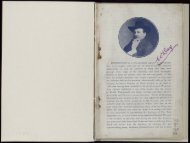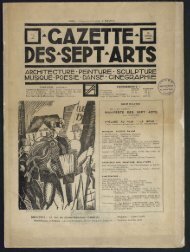Untitled
Untitled
Untitled
Create successful ePaper yourself
Turn your PDF publications into a flip-book with our unique Google optimized e-Paper software.
CHAPTER IV.<br />
lbonic,inabe expgen, (Sas lbotbco, Etc.<br />
BEFORE the introduction of compressedgases and the use<br />
of steel cylinders had rendered the purchase and transmission<br />
of forty feet of oxygen from London to John o' Groats as easy<br />
and as cheap as the forwarding of, say, a churn of milk for<br />
the same distance, lanternists were compelled to use either<br />
the delicate, expensive, and rapidly-ruined gas bag, or the<br />
anything but portable pneumatic gas holder. As both of<br />
these forms are still in use to some extent, and as the<br />
latter, at any rate for certain purposes, can still hold its own,<br />
a word as to their use will not be out of place. At the same<br />
time, we can appropriately bracket with these forms of<br />
apparatus the manufacture of oxygen at home.<br />
Gas bags, which are generally wedge-shaped, are made, at<br />
least the better qualities are, of a<br />
stout fabric bag enclosed in another<br />
of a close-textured twill, between<br />
which is a third bag of thin sheet<br />
india-rubber (Fig. 12). The outlet of<br />
the bag, a brass stopcock, is fixed in<br />
the middle of the edge formed by<br />
the acute angle of the bag. This stopcock,<br />
in the case of bags used to re-<br />
Fig. 12. A GAS BAG.<br />
tain oxygen made from potassium<br />
chlorate, rapidly becomes corroded<br />
by chlorine, which is generally present in small quantity in such<br />
gas, unless care is taken to get rid of it (see page 23), which<br />
HOME-MADE OXYGEN, GAS HOLDERS, ETC. 19<br />
should always be done. The wedge-shaped bag, when being<br />
filled, is allowed to lie freely on the table, but when thegas is<br />
being used, is inserted between pressure boards (Fig. 13), the<br />
upper one of which is weighted<br />
to the requisite degree to expel<br />
the gas. Weights are placed<br />
at the extremity of the board,<br />
against the shelf provided to<br />
prevent them slipping down,<br />
and may vary in amount from<br />
a half - hundredweight to<br />
three or even four times that<br />
amount. For most purposes,<br />
where a moderate size of disc<br />
Fig. 13. DOUBLE PRESSURE BOARDS<br />
is required, which in these<br />
days will probably be the<br />
only case in which gas bags<br />
are used at all, a single 56 lb. weight will be sufficient<br />
to commence with on a full bag, being supplemented with<br />
another when the bag is more than half empty. When<br />
using oxygen from a bag with house gas there is very little<br />
danger of the latter entering the oxygen bag and forming<br />
with its contents an explosive mixture, since the pressure<br />
in the gas mains is but slight. It must be borne in mind,<br />
however, that if at any time the two gases were mixed in a<br />
bag, the result would in all probability be an explosion<br />
which might endanger life and limb. This is far more likely<br />
to occur when a mixed jet is being worked with both gases<br />
in bags (this form of jet cannot be used with house gas<br />
taken direct from the mains to the lantern, on account of<br />
insufficient pressure), and the pressure in the two bags is not<br />
equal. To get over the difficulty of maintaining the pressure<br />
in two sets of bags and boards equal, double pressure boards<br />
were invented, in which the same weights are imployed to<br />
press down the two bags. When this forth is used, the apex<br />
of the boards at A, Fig. 13, which when the bags are full is<br />
raised, must be lowered by folding in the strut B before the<br />
top board has sunk so low as either to overturn the entire<br />
frame or to cause the weights to slide off. By the use of pressure<br />
boards longer than the bags this can also be prevented.<br />
B2

















